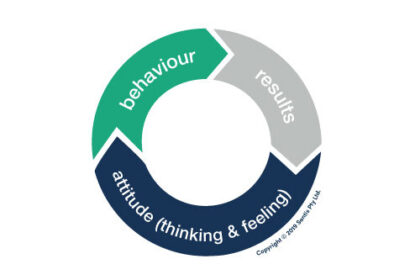Imagine this. You’re a safety leader for a large operational site. There’s been a series of incidents and the executive team is under pressure to make a change to improve safety performance, fast. The series of events that follow look a little bit like this:
First, you focus on the physical environment, reducing riskby investing in equipment, tools, planning and design. You see an improvement in safety performance.
Next, you focus on making sure that policies and procedures are in place, toolbox talks are set up and that risk assessments are completed.Again, this leads to an improvement.
As time goes on, you rinse and repeat the above steps,gradually adding more controls. Slowly you notice that, while safety performance has improved, you’re not seeing the same scale of improvement you once did. In fact, performance either starts to plateau or worse, begins to trend in the wrong direction.
Sound familiar? We hear this story time and time again from our clients, regardless of industry.
Warning signs that your safety performance has plateaued (or is about to)
1. Improvements in safety results have rapidly slowed down
A tell-tale sign of a safety plateau is when you’ve experienced steady improvements in your safety performance that have rapidly tailored off. This is especially common with organisations that haven’t previously invested in safety initiatives as they’ll see the largest improvements in safety performance from changes in environmental and procedural factors before results plateau.
2. Your team is less engaged during safety briefings
When you first started running regular safety briefings, your team appeared to be highly engaged. There were open lines of communication, inquisitive questions and a general sense of enthusiasm towards excelling in safety. But as time went on, you started to notice their waning attention, disengagement during briefings and a general sense of disinterest. What was once important has become yet another procedure that they have to attend to.
3. A reduction in incidents that doesn’t correlate with injury rates
In theory, a reduction in incidents reported should lead to a reduction in injury rates as it indicates that there are fewer circumstances arising in your workplace where an injury could occur. But yet, even though fewer incidents are being reported, your injury rates haven’t changed. That’s an indication that while your team might appear to be engaged with your safety initiatives when they’re under supervision, unhelpful beliefs about safety or the perceived risks associated with reporting an incident may be leading to increased rates of underreporting.
The hidden risk
As safety performance plateaus, tensions rise. When an incident occurs, the natural tendency for many leaders is to look for someone to blame. The result? Leaders become reactive to issues and teams become ever-resistant and resentful of the ‘safety police’. Before you know it, organisations find themselves operating in a safety culture of blame and avoidance where every error or violation is linked to someone to blame, but no one to take responsibility.
In a safety culture dominated by blame and avoidance:
- teams avoid engaging with key safety practices, or only engage when supervised
- a reactive leadership team focuses on easy safety corrections such as enforcing the use of PPE, but doesn’t have ‘time’ to close out more complex critical safety activities
- each department or role level in the business directs blame for poor performance at everyone but themselves.
You can have all the right equipment, systems and processes in place, but if your people lack the personal motivation to use these properly, your organisation will only be as safe as your least safe worker.
To break this cycle, deliberate action must be taken to shift from a blame and avoidance culture to an ownership and responsibility culture. So, how do we approach this?
A simple model for change
For an organisation to truly shift its safety culture, a series of smaller changes must first occur. Specifically, a change in attitude from both leaders and team members.
So how does individual change happen? And what are the considerations for organisations when seeking to drive change?
In order for individual change to occur, three foundational conditions must exist:
- A clear, motivating reason(s) for change
- The knowledge of how to change
- An environment that supports the change
 (Adapted from DiClemente & Prochaska)
(Adapted from DiClemente & Prochaska)
It’s important to understand that change is a process. A simple model for change is to explore the ‘Stages Of Change Model’ put forward by psychologists DiClemente & Prochaska (1998).
This model breaks down the process of behaviour change into five key stages:
Stage 1 – Precontemplation: When you have no intention or awareness about the need to change.
Stage 2 – Contemplation: When you’ve considered a need to change in the future, but have no plans to do anything about it yet.
Stage 3 – Preparation: When you have a plan for change and have started taking small steps towards it.
Stage 4 – Action: When you’re fully engaged with the new change, but it’s yet to become second nature.
Stage 5 – Maintenance: When you’ve cemented the change and have been behaving in that manner for around six months.
Most safety initiatives that focus on enforcing policies and procedures target what’s known as behaviour modification. That is, what people need to do to stay safe. In DiClemente & Prochaska’s model (1998), this is the equivalent of jumping straight to stage four—action. In these cases, some of the workforce will respond positively to this because they’ve already contemplated and prepared for this change independently. However, many will resist because they perceive that they are being told what to do with no clear understanding of why or what’s in it for them. The result? A culture where workers do what they are told, when they are being watched.
Help your workers see value in behaving safely for themselves
So, taking a psychology-focused approach to safety improvement, what can be done differently?
Stage 1 – Precontemplation: Focus on the ‘why’ of safety by helping individuals to identify their own motivations to make safe choices. Note: This is unlikely to be the organisation’s TRIFR or the bonus incentives of the leadership team. The reasons should be personal and relate back to what’s in it for them.
Stage 2 – Contemplation: Focus on the individual ‘why’ of team members and ask them to begin sharing. Find commonalities in personal safety motivations and link these to the goals of the organisation and the team.
Stage 3 – Preparation: Visualise what safety could look like if done well and if ownership and responsibility was taken. Unpack barriers to achieving improved safety performance, address hindering attitudes and beliefs, and begin fostering a supportive culture.
Stage 4 – Action: Put the new attitudes and commitments into action and work hard to recognise the wins as they are achieved.
Stage -5 Maintenance: Implement reward and recognition programs and key metrics to ensure the gains are maintained.
In parallel to this, it is crucial that organisational changes match the commitment of the individuals involved in the change. Strong, effective leadership is critical to success as it has a direct correlation with team behaviour and safety performance (see The Safety Leadership Link ).
Where to from here
To summarise, unlike fear-driven approaches or behaviour-based safety strategies, taking a psychology-focused approach to your safety improvement efforts flips the script by actively motivating your workers to push themselves towards safety excellence.
Instead of enforcing policies and punishment upon them, this approach guides them through the stages of change and helps them come to their own conclusions about the importance of safety, helping build a sense of intrinsic motivation towards behaving safely even when they aren’t being watched.
By shifting their approach, organisations can break through the safety plateau and create a culture where workers are motivated to excel in their safety performance, simply because they choose to.
Download the Business Case for Psychology-Based Safety Programs to learn more about how you could benefit from a new approach to safety in your business.
References
DiClemente, C. C., & Prochaska, J. O. (1998). Toward a comprehensive, transtheoretical model of change: Stages of change and addictive behaviours. In W. R. Miller & N. Heather (Eds.), Treating addictive behaviours (pp. 3-24). New York: Plenum.
Laforge, R. G., Velicer, W. F., Richmond, R. L. & Owen, N. (1999). Stage distributions for five health behaviours in the United States and Australia. Preventive Medicine: An International Journal Devoted to Practice & Theory, 28, 61-74.




